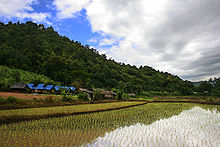
Rice production in Thailand represents a significant portion of the Thai economy and labor force.[1] In 2017, the value of all Thai rice traded was 174.5 billion baht, about 12.9% of all farm production.[2] Of the 40% of Thais who work in agriculture, 16 million of them are rice farmers by one estimate.[3][4]
Thailand has a strong tradition of rice production. It has the fifth-largest amount of land under rice cultivation in the world and is the world's second largest exporter of rice.[5] Thailand has plans to further increase the land available for rice production, with a goal of adding 500,000 hectares (1,200,000 acres) to its already 9.2 million hectares (23 million acres) of rice-growing areas.[6][7] Fully half of Thailand's cultivated land is devoted to rice.[8]
The Thai Ministry of Agriculture projects paddy production for both the main and second crops to hit 27–28 million metric tons (30–31 million short tons) in the 2019–2020 season, dragged down by a drop in second crop production due to floods and drought.[9] Jasmine rice (Thai: ข้าวหอมมะลิ; RTGS: khao hom mali), a higher quality type of rice, is the rice strain most produced in Thailand although in Thailand it is thought that only Surin, Buriram, and Sisaket Provinces can produce high quality hom mali.[10] Jasmine has a significantly lower crop yield than other types of rice, but normally fetches more than double the price of other cultivars on the global market.[6]
Due to ongoing droughts, the USDA has forecast output will drop by more than a fifth to 15.8 million metric tons (17.4 million short tons) in 2016. Thailand can harvest three rice crops a year, but due to water shortages the government is urging a move to less water-dependent crops or forgoing one crop.[11] Rice is water intensive: one calculation says rice requires 1,500 cubic metres (400,000 US gal) of water per cultivated rai.[12]
- ^ "Country Profile: Thailand" (PDF). Library of Congress. Washington DC: Federal Research Division. Jul 2007. Retrieved 2015-01-10.
- ^ Wipatayotin, Apinya (4 November 2018). "Finding ways to beat farm debt". Bangkok Post. Retrieved 4 November 2018.
- ^ "The Rice Mountain". The Economist. 2013-08-10. Retrieved 30 September 2016.
- ^ Blake, Chris; Suwannakij, Supunnabul (23 November 2016). "Thai Junta Flip-Flop on Populism Too Late for Suffering Farmers". Bloomberg. Retrieved 23 November 2016.
- ^ "Thailand wants rice top spot back". Investvine. 2013-02-01. Retrieved 2013-02-14.
- ^ a b "Rice strain is cause of comparatively low productivity". The Nation. 16 April 2008. Archived from the original on August 31, 2009. Retrieved 2 February 2009.
- ^ Ghosh, Nirmal (2008-02-24). "Thailand to set aside more land for farming". Straits Times. Retrieved 1 November 2017.
- ^ Poapongsakorn, Nipon; Chokesomritpol, Phunjasit (2017-06-30). "Agriculture 4.0: Obstacles and how to break through". Thailand Development Research Institute (TDRI). Retrieved 15 September 2017.
- ^ Cite error: The named reference
BP-20200106was invoked but never defined (see the help page). - ^ Yongcharoenchai, Chaiyot (6 November 2016). "The Rice Man Cometh". Bangkok Post. Retrieved 10 November 2016.
- ^ Cite error: The named reference
Reuters-20160501was invoked but never defined (see the help page). - ^ Wipatayotin, Apinya (2017-10-08). "Law wades into choppy waters". Bangkok Post. Retrieved 2 November 2017.